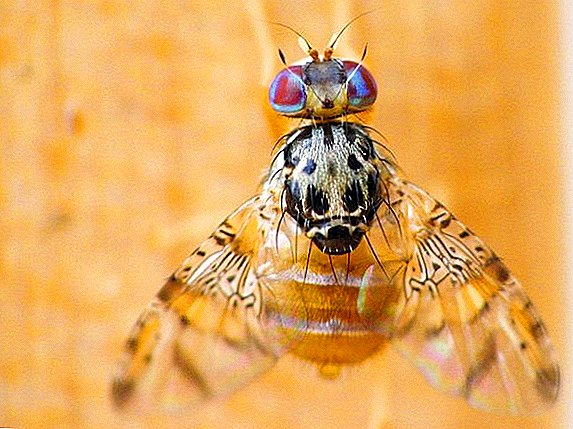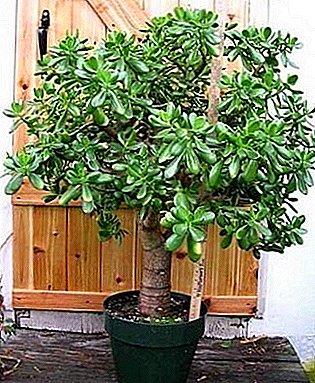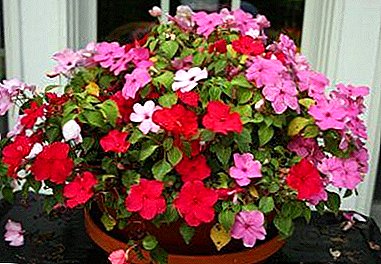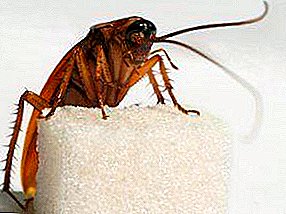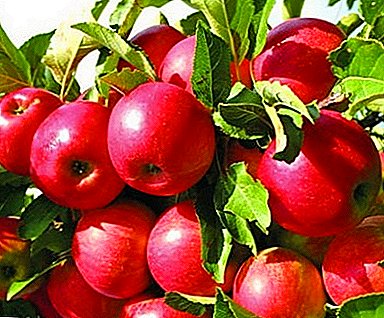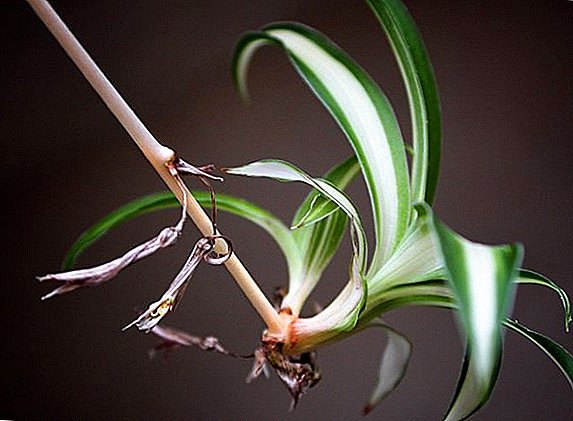 Not so long ago on the windowsills and loggias of our houses there were almost the same types of flowers. But now the picture has changed - more spectacular ones are added to the familiar plants. The interest to them in amateur growers is purely practical: after all, I want the plant to be unusual and easy to maintain. Under these parameters is ideal Mühlenbeckia, which deserves a detailed description.
Not so long ago on the windowsills and loggias of our houses there were almost the same types of flowers. But now the picture has changed - more spectacular ones are added to the familiar plants. The interest to them in amateur growers is purely practical: after all, I want the plant to be unusual and easy to maintain. Under these parameters is ideal Mühlenbeckia, which deserves a detailed description.
Description
Mühlenbeckia is an evergreen perennial in the form of a shrub or shrub. Strictly speaking, this is the name for a whole botanical genus of plants, numbering 20 species.
Their root system is represented by the lobes, and a bunch of thin stems of brown or brown color can be seen above the ground. Due to the creeping nature of growth, they add a good length and intertwine - in the end, the plant looks like a crumbly green liana.
Like Mühlenbeckia, the Buckwheat family also includes: sour sorrel, buckwheat, horse sorrel and rhubarb, which are widely distributed almost throughout the globe.
 Over time, the stems become covered with smooth red bark and become woody. Depending on the conditions and specific type, such processes can have sizes from 15-20 cm to 3 m.
Over time, the stems become covered with smooth red bark and become woody. Depending on the conditions and specific type, such processes can have sizes from 15-20 cm to 3 m.Bright green leaves on short petioles cover all the stems (in the regular order). They themselves are small: 0.6-2 cm, with a shiny plane of smooth plates. If you look closely, it turns out that the leaves can be oval, round or lobed.
Flowering time comes in August. At this time, small (5-6 mm) white-green flowers with a number from 2 to 5, each with five petals, appear on the inflorescences. Having opened, they exude a delicate sweetish aroma that attracts butterflies, bees and other insects. 
Important! Considering the transfer of bushes to open ground, remember the necessary distance - Mühlenbeckia with its violent growth and tenacious roots can slow down the growth of species growing nearby.After the flowers have faded, their place is taken by the fruit - a box-shaped mini-achenel with a huge amount of miniature seeds.
During the rest period, the plant drops part of the foliage.
This green miracle came to our latitudes from Australia and the archipelagoes of Oceania. Large arrays of "wild" Mühlenbeck are also found in South America and on the west coast of Africa.  The most compact types and varieties are used as room ones, namely:
The most compact types and varieties are used as room ones, namely:
- Mühlenbeckia encompassing - the most popular line, which became the basis for the selection of other indoor species. With proper care, its height reaches from 15 cm to 1 m. Red-brown stems are densely covered with leathery small foliage (0.5-1.5 cm in diameter). Shoots grow very actively, which allows the use of the plant for the decoration of arches and niches. Greens in age specimens are pleasing to the eye with a color game: the young leaves are bright, while the older ones stand out in a dark green tone;
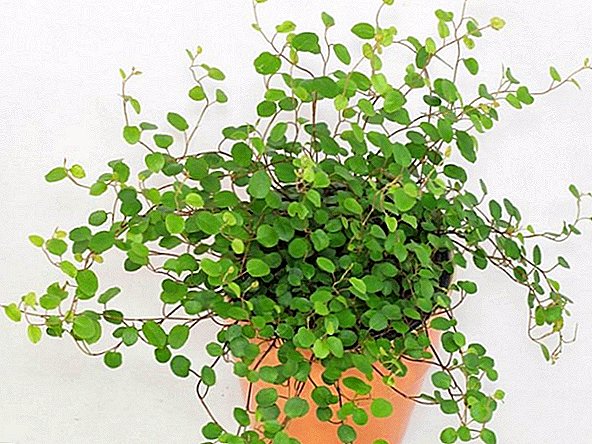
- mühlenbeckia nana - similar to the previous line, but flaunts a thicker leaf cover. The leaves themselves are very small - their dimensions rarely reach even up to 1 cm;
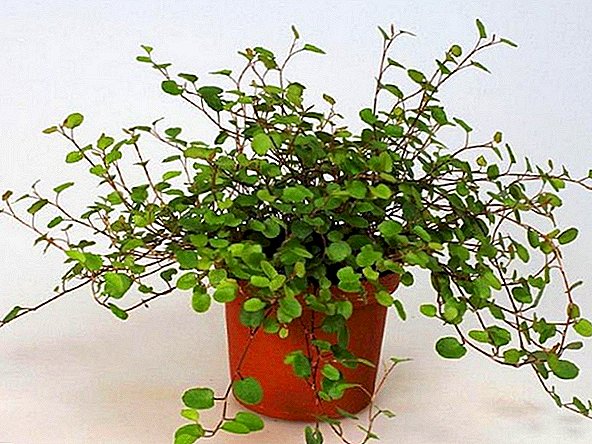
- mühlenbeckia microfilm - it is distinguished by round leaves of medium size;
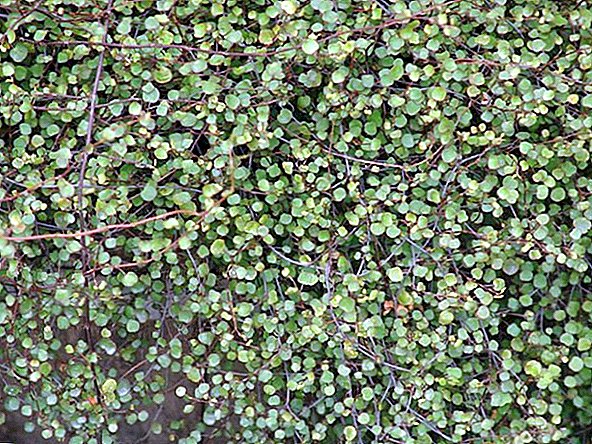
- Myulenbeckia krupnolistnaya (or grandiflora) - the name speaks for itself: the greens of this variety are much larger (even more than those of wild-growing species), some shoots can grow up to 2.3-2.5 cm;
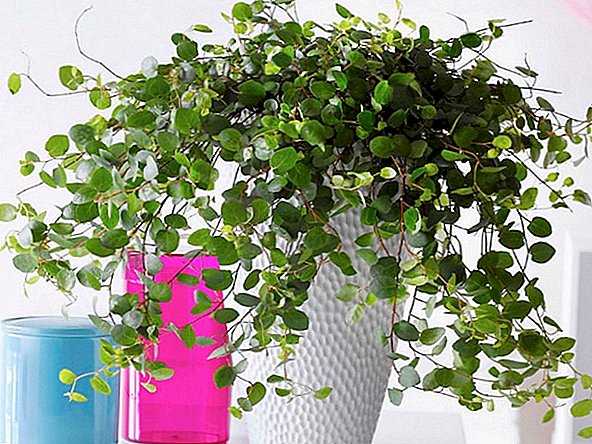
- Mülenbekia Māori - it is allocated with an oval form of 2-centimeter leaves. The lower part of the plate with a reddish tinge visually extends the petiole;
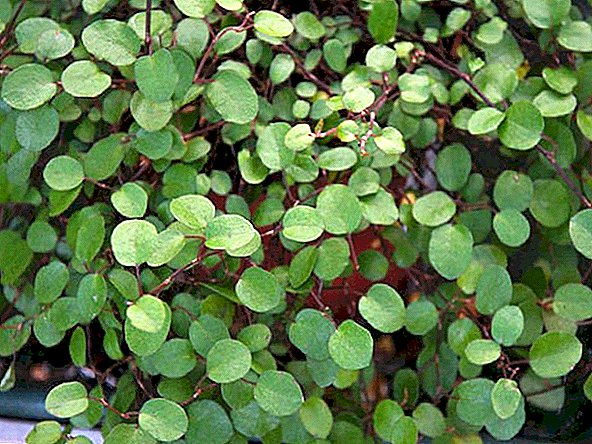
- Mühlenbeckia Tribolatechess - its main feature is three pronounced lobes on the leaves.
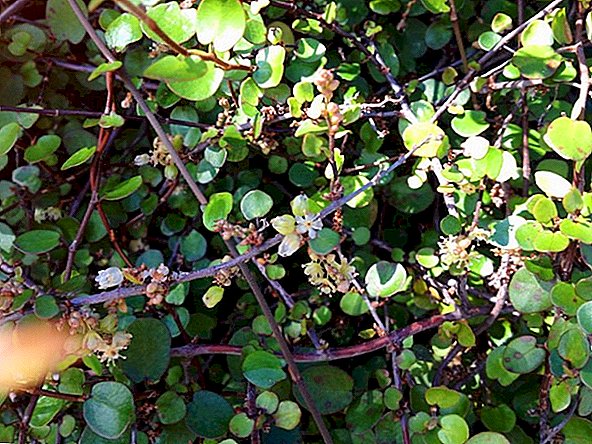
Ampiel plants are flowers that grow most in hanging pots. In addition to Mühlenbeckia, they also include: vervain ampelous, ampelous begonia, ampelous lobelia, ampelous fuchsia, room lianas, silver dichondra, eschinanthus, and amber dichondra.
Care
Even a beginner grower can cope with the cultivation and maintenance of Mühlenbeckia - the plant is considered unpretentious. But care for such beauty has its own nuances, which is desirable to know.
Lighting
The plant prefers diffused light, although it responds well to partial shade. It is desirable to exclude the ingress of direct sunlight - they simply dry the leaves, and with prolonged exposure they can shrivel the stems.
Did you know? This genus of plants received its name in honor of Swede H.G. Mühlenbeck, through which these bushes and fell into the "scientific revolution".

Based on this, the optimal location will be a shaded window in the western or eastern part of the house. In the hot season, Mühlenbeckia is moved away from the window or transferred to the northern window-sill.
Temperature
Thermophilous vine in warm time requires a stable temperature of + 20 ... +24 ° С. The admissible short-term minimum is +18 ° С. True, it is not worth holding the plant in such a mode for a long time, otherwise the growth rates will slow down significantly.
In the cold season, at rest, content will be required at constant + 10 ... +14 ° C. Seeing that the leaves began to fall off closer to winter, do not worry - this is a natural reaction to the change of season. 
It is at this point that some people sometimes make the mistake of putting a container with Mühlenbeckia in a warmer place. Just this can not be done: the shoots will stretch, turning the bush until now tidy into a shapeless bundle.
Important! Shrubs, especially young ones, are most afraid of hypothermia and the direct rays of the midday sun (they are equally destructive).Regardless of the time of year, the plant must be protected from temperature fluctuations and, of course, drafts. As you may have guessed, it is advisable to avoid too close proximity to the heating devices and placing the pot near the doorways.

Watering
During the growing season (spring and summer), Mühlenbeckia is watered 2-3 times a week. To do this, take exceptionally soft, separated water at room temperature.
The rhizome is very sensitive to waterlogging, so immediately after watering, water is drained from the pan. For normal growth, the soil should be moderately wet: it is harmful both to a permanent "swamp" and to the soil, which had time to crack.
If the summer was hot and the temperature in the room exceeded +23 ° C, the bush is sprayed daily with water - this will keep the desired balance of moisture and leaf color. 
During the wintering period, the number of water procedures is reduced, sometimes replacing them with abundant spraying. Experienced growers note that at this time more drying of the substrate is allowed.
Top dressing
The need for "recharge" arises only from May to August - in too early contributions there is no need.
The frequency of feeding is 1 every 2-3 weeks. For such procedures mineral fertilizers are best suited for flowering indoor species.  Fertilizers for flowering houseplants
Fertilizers for flowering houseplants
Did you know? Wild specimens of the South American range can withstand temperatures up to -12 without any special losses. °WITH.Some use formulations for decorative deciduous varieties. No doubt, the leaves need additional feeding, but in such mixtures the balance of trace elements is not quite suitable for Mühlenbeckia. When introduced, they will have a good effect on the green mass, but the roots will feel a lack of valuable compounds.
Pruning
This species is well tolerated shaping, and thin stems are easy to process. The main thing is to use a sharp instrument that was disinfected with alcohol or a weak solution of potassium permanganate, and do not forget to process the sections with sulfur powder or crushed charcoal.
Potassium permanganate is an effective and reliable antiseptic used in gardening. Learn how to use potassium permanganate in the garden and in the garden.

Bare and elongated stems are pruned in early spring, before the growing season. Formative pruning is carried out during growth. Moreover, Mühlenbeckia allows you to experiment with the form: using various props and cascades, the plant can be turned into a whole composition.
More radical, sanitary pruning, required "running" instances that have grown excessively. In such cases, more than half of the shoots are removed - this stimulates the thickening, which in the future will allow you to give the bush the desired shape. 
Transfer
Transplantation is carried out once a year, in mid-April. Its sequence is as follows:
- First prepare a suitable container. It should be 2-3 cm longer than the previous Mühlenbeckia’s “place of residence”.
- Then there lay the substrate. For such purposes, universal soil mix or commercial soil for decorative hardwood lines will fit. You can prepare the soil yourself, mixing in equal shares garden soil, coarse sand and peat. Often taken, and other compositions - with the participation of the same sand, purulent and soddy soil.
- At the bottom of the pot put small (up to 1 cm) clay, which will play the role of drainage. The thickness of the layer increases gradually, starting from 1 cm at the first transplant, and up to the final 3-5 cm. The mixed soil lies on top.
- The soil under the bush itself is slightly moistened, after which the plant is gently removed. Young specimens gently shake out, holding the ground, older ones - undermined with a spatula. The most important thing: the transfer to a new place is carried out only by the method of transshipment (that is, with an earthen clod). The fact is that the roots are extremely sensitive not only to damage, but even to contacts with other objects.
- Rhizome extremely carefully placed in the hole, made in a new layer of soil and pre-watered with a small amount of water. Then it is covered with soil, and the upper layer is tried to lightly padded with fingers. Everything, Mühlenbeckia "moved."

Important! Transplantation is done on a warm day, with strict observance of temperature.Be prepared for the fact that for the first month and a half the bush will not be too eager to grow (stress affects the gentle root). After this period, everything returns to normal.
Another point is connected with the transplant, which causes questions to novice florists. Many reference books recommend using only soil with an acidity of 5.8-6.2 pH. Although in practice it is possible and not to adhere to such strict norms: it is not so much the numbers that are important as the fertility and friability of the soil.
To find out which soil for the plant will be most favorable, read how to independently determine the acidity of the soil in the area.

Diseases and pests
Mühlenbeckia has a fairly strong immunity, but errors in the content can trigger a number of diseases. Most often the plant suffers from:
- yellowing of the leaves caused by excessively dry air. Spraying and maintaining normal humidity in the room will help restore a healthy color;
- fall of shoots and drying of leaves. In this case, the bush is enough to protect from direct sunlight (placing in partial shade);
- leaf fall, which indicates excessive dryness of the soil or its waterlogging. To avoid such difficulties, follow the rules of watering;
- root rot (also a consequence of waterlogging). The process of “treatment” is quite traumatic for Mühlenbeckia - the bush will have to not only be removed from the soil, but also cut off the affected roots. The cut is sprinkled with gray or fine wood charcoal, after which the still live roots are dipped in a 0.2% solution of "Topsin-M" or "Fundazole". In the final - transfer to a clean substrate, treated with the same compounds or with benlate 0.1%. For prevention, the plant is treated with a solution of colloidal sulfur (in 3 sets with a break of 10-14 days).

Did you know? Mühlenbeckia is considered a “relative” of buckwheat (both plants are part of the Buckwheat family).With room pests lucky - she has only one "opponent", which can attack the greens. This is a spider mite. These small (up to 1 cm) mites are dangerous in that their eggs can hibernate for up to 5 years, and it is quite simple for adults to reach the leaves by switching from other plants or by entering through an open window on the first floors.
Spider mite can deliver a lot of problems to the grower and gardener. Read how to deal with spider mites.Fighting this scourge involves several steps:
- daily preventive spraying. For Mühlenbeckia, this is not the most effective technique: they are performed only in the summer, and if you are close to already affected species, it will not produce any result at all;
- removal of all yellowed leaves with obligatory washing of the stems and leaves with water;
- the plant is sprayed with an infusion of onion peel (100 g of raw materials for 5 liters of water, 4-5 days of aging). Insecticides of the Fitoverma type give a stronger effect. This drug is used 3-4 times with a break of 7-10 days.

In order to avoid complications, it will be necessary to process all the flowers that are close to the preserved Mühlenbeckia.
Breeding
Many are interested in the question - how realistic is it to replenish their collection with their own hand-grown bushes. This is quite a feasible task, especially if you know the technology of their reproduction in various ways.
Cuttings
The method is used in the period of peak growth (late July - early August) and involves simple manipulations:
- from the tops of the strongest shoots, cuttings of 10–12 cm long are cut at an angle;
- then the branches are placed in a glass or a jar of water at room temperature;
- after about 2 weeks they will repulse the roots;
- seeing such shoots, they are planted in a nutrient light soil, you can take the composition for adult bushes. In one pot is placed 4-5 cuttings.
 Mühlenbeckia stalk
Mühlenbeckia stalkImportant! The container for cuttings must be disinfected (usually the walls are washed with a solution of potassium permanganate).Further care is reduced to the standard procedures described above.
Seeds
Having the purchased seeds or the material obtained by pollination, and waiting in this case a month before the seeds mature, you can proceed. The following works are carried out in mid-April:
- The seeds are placed in a peat-sand substrate at intervals of 2-3 cm and sprinkled with soil. It should be a layer of 5-8 mm;
- the first watering in the form of spraying with clean water is also done immediately;
- crops are covered with foil and placed in a warm, well-lit place. So that they do not suffocate, the coating is periodically removed, if necessary, conducting spraying;
- after 2 weeks, the first shoots appear and the shelter is finally removed;
- Having seen 3-4 true leaves, start diving in separate pots.
 Reproduction of mühlenbeckia seeds
Reproduction of mühlenbeckia seedsAfter the "resettlement" all the attention - to moderate watering, support for temperature and light regimes.
Layering
Get young plants really and through the use of layering:
- next to a strong stem put a container of soil;
- there is a suitable escape. At the same time, it is deepened into the substrate at the level of interstitial ligament and well sprinkled with earth;
- after 10-14 days, the shoot will repulse the roots, and it will be separated from the mother bush. Both transplantation and the contents in the "original" container are allowed (this is even preferable, because you do not need to injure the plant again).

Did you know? Surprisingly, disputes over the exact number of Mühlenbeckia species have not abated until now. The figure 20 is generally accepted, although many biologists insist on the number 12 "clean" lines.As you can see, there are no particular difficulties, except for a little accuracy.
We found out what makes Mühlenbeckia interesting, what types of it are represented in our area and how to grow such a miracle at home. We hope these tips will be useful, and you will be able to replenish your collection of flowers with another amazing plant.
Reviews from the Internet about growing mühlenbeckia










